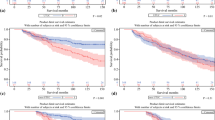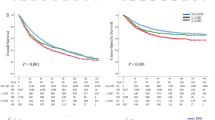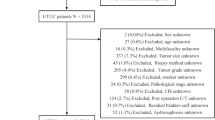Abstract
Background
The influence of a positive surgical margin (PSM) on survival outcome of post radical nephroureterectomy (RNU) for upper urinary tract urothelial carcinoma (UUT-UC) is unclear. The objectives of this study were to determine the significance of PSM on cancer-specific survival (CSS), recurrence-free survival (RFS), and metastasis-free survival (MFS) post RNU.
Methods
From a multicenter collaborative database, data on SM status, stage, grade, lymph node status, lymphovascular invasion (LVI), tumor location, follow-up, and survival was retrieved for 472 patients. Patients underwent open RNU with bladder cuff excision. Clinicopathological features were compared using χ2 or Fisher exact test and unpaired t test for categorical and continuous variables, respectively. Survival was estimated using the Kaplan–Meier method, and univariate and multivariate Cox proportional hazards regression models were calculated.
Results
Median follow-up was 27.5 months (12.1–49.3 months). PSM was identified in 44 patients (9.3 %) and correlated with pT stage (p = 0.002), grade (p < 0.001), LVI (p < 0.001), and location (p < 0.001). Univariate analyses revealed that PSM was a poor prognostic factor for CSS, RFS, and MFS (p = 0.003, 0.04, and <0.001, respectively). The 5-yr CSS and MFS for PSM was 59.1 and 51.6 %, respectively, compared with 83.3 and 79.3 % for patients with negative SM. Multivariate analyses revealed that SM status was an independent predictor of MFS [hazard ratio 2.7; p = 0.001).
Conclusions
PSM after RNU is an important prognostic factor for developing UUT-UC metastases. The status of the surgical margin should be systematically reported on the pathological report and may be a useful variable to include in nomogram risk prediction tools.


Similar content being viewed by others
References
Hall MC, Womack S, Sagalowsky AI, Carmody T, Erickstad MD, Roehrborn CG. Prognostic factors, recurrence, and survival in transitional cell carcinoma of the upper urinary tract: a 30-year experience in 252 patients. Urology. 1998;52:594–601.
Olgac S, Mazumdar M, Dalbagni G, Reuter VE. Urothelial carcinoma of the renal pelvis: a clinicopathologic study of 130 cases. Am J Surg Pathol. 2004;28:1545–52.
Roupret M, Zigeuner R, Palou J, Boehle A, Kaasinen E, Sylvester R, et al. European guidelines for the diagnosis and management of upper urinary tract urothelial cell carcinomas: 2011 update. Eur Urol. 2011;59:584–94.
Dotan ZA, Kavanagh K, Yossepowitch O, Kaag M, Olgac S, Donat M, et al. Positive surgical margins in soft tissue following radical cystectomy for bladder cancer and cancer specific survival. J Urol. 2007;178:2308–12 (discussion 2313).
Novara G, Svatek RS, Karakiewicz PI, Skinner E, Ficarra V, Fradet Y, et al. Soft tissue surgical margin status is a powerful predictor of outcomes after radical cystectomy: a multicenter study of more than 4,400 patients. J Urol. 2010;183:2165–70.
Roupret M, Hupertan V, Traxer O, Loison G, Chartier-Kastler E, Conort P, et al. Comparison of open nephroureterectomy and ureteroscopic and percutaneous management of upper urinary tract transitional cell carcinoma. Urology. 2006;67:1181–7.
Vassilakopoulou M, de la Motte Rouge T, Colin P, Ouzzane A, Khayat D, Dimopoulos MA, et al. Outcomes after adjuvant chemotherapy in the treatment of high-risk urothelial carcinoma of the upper urinary tract (UUT-UC): results from alarge multicenter collaborative study. Cancer. 2011;117:5500–8.
Brown GA, Busby JE, Wood CG, Pisters LL, Dinney CP, Swanson DA, et al. Nephroureterectomy for treating upper urinary tract transitional cell carcinoma: time to change the treatment paradigm? BJU Int. 2006;98:1176–80.
Wu ZY, Wan J, Zhao G, Peng L, Du JL, Yao Y, et al. Risk factors for local recurrence of middle and lower rectal carcinoma after curative resection. World J Gastroenterol. 2008;14:4805–9.
Novais EN, Demiralp B, Alderete J, Larson MC, Rose PS, Sim FH. Do surgical margin and local recurrence influence survival in soft tissue sarcomas? Clin Orthop Relat Res. 2010;468:3003–11.
Kupelian PA, Katcher J, Levin HS, Klein EA. Stage T1-2 prostate cancer: a multivariate analysis of factors affecting biochemical and clinical failures after radical prostatectomy. Int J Radiat Oncol Biol Phys. 1997;37:1043–52.
Abouassaly R, Alibhai SM, Shah N, Timilshina N, Fleshner N, Finelli A. Troubling outcomes from population-level analysis of surgery for upper tract urothelial carcinoma. Urology. 2010;76:895–901.
Novara G, De Marco V, Gottardo F, Dalpiaz O, Bouygues V, Galfano A, et al. Independent predictors of cancer-specific survival in transitional cell carcinoma of the upper urinary tract: multi-institutional dataset from 3 European centers. Cancer. 2007;110:1715–22.
Ku JH, Choi WS, Kwak C, Kim HH. Bladder cancer after nephroureterectomy in patients with urothelial carcinoma of the upper urinary tract.Urol Oncol. 2011;29:383–7.
Mazeman E. Tumors of the upper excretory urinary tract, calices, renal pelvis and ureter. J Urol Nephrol (Paris). 1972;78:Suppl 9:1–219.
Isbarn H, Jeldres C, Shariat SF, Liberman D, Sun M, Lughezzani G, et al. Location of the primary tumor is not an independent predictor of cancer specific mortality in patients with upper urinary tract urothelial carcinoma. J Urol. 2009;182:2177–81.
Ouzzane A, Colin P, Xylinas E, Pignot G, Ariane MM, Saint F, et al. Ureteral and multifocal tumours have worse prognosis than renal pelvic tumours in urothelial carcinoma of the upper urinary tract treated by nephroureterectomy. Eur Urol. 2011;60:1258–65.
Chromecki TF, Cha EK, Fajkovic H, Margulis V, Novara G, Scherr DS, et al.The Impact of tumor multifocality on outcomes in patients treated with radical nephroureterectomy. Eur Urol. 2012;61:245–53.
Rischmann P, Bittard H, Chopin D, Coloby P, Davin JL, Irani J, et al. AFU recommendations 1998. Committee on Cancer of the French Association of Urology. Prog Urol. 2002;12:1159–60.
Roupret M, Wallerand H, Traxer O, Roy C, Mazerolles C, Saint F, et al. Checkup and management of upper urinary tract tumours in 2010: an update from the committee of cancer from the French National Association of Urology. Prog Urol. 2010;20:260–71.
Irani J, Bernardini S, Bonnal JL, Chauvet B, Colombel M, Davin JL, et al. Urothelial tumors. Prog Urol. 2007;17:1065–98.
Jeldres C, Sun M, Lughezzani G, Isbarn H, Shariat SF, Widmer H, et al. Highly predictive survival nomogram after upper urinary tract urothelial carcinoma. Cancer. 2010;116:3774–84.
Margulis V, Youssef RF, Karakiewicz PI, Lotan Y, Wood CG, Zigeuner R, et al. Preoperative multivariable prognostic model for prediction of nonorgan confined urothelial carcinoma of the upper urinary tract. J Urol. 2010;184:453–8.
Acknowledgment
The authors would like to kindly thank other collaborators from the French collaborative national database on UUT-UC: Emilie Adam, Baptiste Albouy, Medhi-Mokhtar Ariane, Frédéric Arroua, Marie Audouin, Marie Dominique Azemar, Henri Bensadoun, Pierre Bigot, Franck Bruyère, Luc Cormier, Jean-Nicolas Cornu, Sébastien Crouzet, Olivier Cussenot, Francky Delage, Alexandre De la Taille, Aurélien Descazeaud, Stéphane Droupy, Emmanuel Ravier, Pascal Gres, Julien Guillotreau, Nicolas Hoareau, Alain Houlgatte, Sophie Hurel, Gilles Karsenty, Jean Alexandre Long, Charlotte Maurin, Véronique Phé, Thomas Polguer, Mathieu Roumiguié, Frédéric Staerman, Michel Soulié, and Evanguelos Xylinas.
Author information
Authors and Affiliations
Corresponding author
Additional information
This study was conducted on behalf of the French Collaborative National Database on UUT-UC.
Rights and permissions
About this article
Cite this article
Colin, P., Ouzzane, A., Yates, D.R. et al. Influence of Positive Surgical Margin Status After Radical Nephroureterectomy on Upper Urinary Tract Urothelial Carcinoma Survival. Ann Surg Oncol 19, 3613–3620 (2012). https://doi.org/10.1245/s10434-012-2453-9
Received:
Published:
Issue Date:
DOI: https://doi.org/10.1245/s10434-012-2453-9




